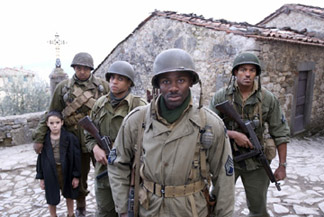Movie Review: Miracle at St. Anna
By Matthew Huntley
October 6, 2008
BoxOfficeProphets.com

Lee and screenwriter James McBride, who adapted from his own novel of the same name, infuse Miracle with hokey melodrama, awkward humor and conventional war violence. Speaking of the violence, because the landscape of Hollywood war pictures is so broad and prolific, it takes a brutal film like Saving Private Ryan or Black Hawk Down to really catch our attention. In Miracle, the violence seems watered down. Because we expect it, and because Lee delivers it in a traditional way, we're not as moved by it. I feel strange saying this, but the violence needed to be more special, or else we needed to be more invested in the characters behind it.
The story actually begins in 1983, when an old black man sits in his New York City apartment watching The Longest Day with John Wayne, the 1962 epic about the Allied invasion of Normandy. The man shuts it off in disgust, which seems to be Lee's way of attacking Hollywood war movies because few of them feature African Americans in prominent roles.
The old man is Hector Negron, a widower who works at a city post office. Negron is just three months shy of retirement, but when a foreign white man steps up to the counter to buy some stamps, Negron pulls out a Luger and shoots him point blank in the chest. At police headquarters, he's interviewed by an ambitious young reporter (Joseph Gordon-Levitt), who finds a particular angle on the story after he and two cops discover Negron was hiding the sculpted head from the Ponte Santa Trinita Bridge in Florence. Why would this old man have such a thing buried in his closet?
That's the question that motivates the movie to flash back to 1944. When we first see it the sculpted head, a big fella has it tied to his waist as he and other soldiers from the all-black 92nd Division, nicknamed Buffalo Soldiers, cross the Serchio River in Tuscany. During their march, a German woman speaks over the radio trying to undermine their confidence by telling them how much their country hates them. The Germans are hoping they'll crack down before their attack.
Four of these black men - Sergeant Aubrey Stamps (Derek Luke); Sergeant Bishop Cummings (Michael Ealy); a young Corporal Negron (Laz Alonso); and PFC Sam Train (Omar Benson Miller) - get caught behind enemy lines and must hide out in a small Tuscan Village. Train, the large man carrying the statue head, stumbles into a barn and finds a hurt Italian boy, named Angelo (Matteo Sciabordi), who refers to him as the "Chocolate Giant." Train rescues him and it's their bond that gives the movie its heart.
As the four men prepare for a NAZI invasion (this late in the war, the German SS was retreating northwards), they meet a group of local villagers, among them the beautiful Renata (Valentina Cervi) and her Fascist father (Omero Antonutti). Renata, who speaks fluent English, tells them she's been waiting two years for her husband to come home, but her values shift when Stamps and Cummings show her signs of attraction.
The movie bounces back and forth between the black soldiers and the higher-ranking white men, some of whom support the 92nd Division and others who don't. After a while, too much time is spent between both groups and the narrative starts to go in circles. I grew impatient and even a little bored. It was only during a brutal massacre scene, told in flashback by an Italian partisan (Pierfrancesco Favino), that rekindled my interest. Earlier, when I commented on violence that stands out, this is what I meant.
I'm sure the script for Miracle at St. Anna read emotionally on paper, but I grew exhausted during the screening. I know this is an important story, but it's not told in a compelling or energetic way, which is a surprise since most of Spike Lee's movies contain a greater sense of urgency than most. The acting was sometimes weak and over-the-top, almost to the point where it became melodramatic and cartoonish. One of these instances happens early on, when the reporter and police are searching Negron's apartment. Notice how the detectives try to act tough; it's almost laughable. As is the ending on the beach, when we finally discover what the "miracle" is.
The soldiers themselves feel like stock movie characters: the straight, always serious one; the selfish, womanizing con artist with an attitude; the loner; and the big-hearted teddy bear. None of these men are particularly interesting, though Miller does give a good performance as the "Chocolate Giant," probably because he fit the role so well.
Terence Blanchard's score is the most distracting element of all. Yes, it would be a pleasure to listen to it in a different context, but here it plays through the entire feature, with no break and it doesn't always mix well with the mood of the scene. Rather than advancing the drama or complementing it, it took me out of it and made me lose focus of the characters.
I admire Lee for wanting to put a spin on the traditional war picture, by including humor and showing multiple conflicts at once, but they don't thread well. That's not to say they couldn't, they just don't here. It's true that too few war pictures have made an effort to recognize the roles of African Americans, but this is not the one that will finally do them justice.